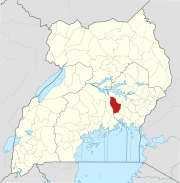Kamuli District
Kamuli District | |
|---|---|
 District location in Uganda | |
| Coordinates: 00°55′N 33°06′E / 0.917°N 33.100°E | |
| Country | |
| Region | Eastern Region of Uganda |
| Sub-region | Busoga sub-region |
| Capital | Kamuli |
| Area | |
| • Land | 1,557 km2 (601 sq mi) |
| Elevation | 1,100 m (3,600 ft) |
| Population (2012 Estimate) | |
| • Total | 500,800 |
| • Density | 321.6/km2 (833/sq mi) |
| Time zone | UTC+3 (EAT) |
| Website | www |

Kamuli District is a district in the Eastern Region of Uganda. The town of Kamuli is the site of the district headquarters.
Location
[edit]Kamuli District is bordered by Buyende District to the north, Luuka District to the east, Jinja District to the south, and Kayunga District to the west. The district headquarters at Kamuli are approximately 74 kilometres (46 mi), by road, north of Jinja, the largest city in the Busoga sub-region.[1]
Population
[edit]In December 1991, the district had a population of about 249,300, according to the national census. In 2002, the census estimated the population at 361,400, with 40.5 percent male and 59.5 percent female. In 2012, the population was estimated at 500,800.[2]
Ethnicity and language
[edit]The district is a multi-ethnic and multi-cultural society, with the predominant ethnic group being the Basoga who comprise 76 percent of the population. The Iteso people make up 3.9 percent and the Banyoro and Bagungu together make up 1.8 percent of the population. Other Ugandan ethnicities make up the remainder (18.3 percent). The predominantly language spoken in Kamuli District is Lusoga, with some Luganda and English.[3]
The district is part of the Busoga sub-region, which is coterminous with the Kingdom of Busoga.[4]
Economic activities
[edit]Means of earning a livelihood in Kamuli District include:[5]
- Fishing
- Ranching
- Farming
- Fish farming
- Bee keeping
- Retail trade
- Quarrying
The crops grown include the following:
- Upland rice
- Paddy rice
- Matooke
- Sweet bananas
- Maize
- Millet
- Soybeans
- Groundnuts
- Oranges
- Mangoes
- Potatoes
- Beans
- Simsim
- Sunflower
- Tomatoes
- Onions
- Coffee
- Cotton
- Sugarcane
Livestock kept includes cattle, goats, sheep, and chicken.
Non-government organizations
[edit]Since 2003, Iowa State University's Center for Sustainable Rural Livelihoods has worked side-by-side with Kamuli District residents to discover and implement sustainable solutions to meeting the community's most urgent needs. Starting with farmer training, the center has evolved into programming that touches every stage of the life cycle.[6] The Iowa State University-Uganda Program is headquartered in Kamuli.
Uganda Community Farm is a non-profit community agribusiness organisation that equips participating farmers with farming materials, offers training for growing crops adapted to local conditions, and builds market access for selling their crops.[7] Started in 2013 as a pilot project farming 5 acres,[8] the organisation expanded to several programs. As of 2020, the organisation has trained and supported 500 farmers within the Kamuli and Buyenda districts to grow white sorghum.[9] Uganda Community Farm is headquartered in Kamuli.
Notable people
[edit]- Patrick Kimumwe - Ugandan soldier, rebel, and author[10]
See also
[edit]References
[edit]- ^ "Road Distance Between Jinja And Kamuli With Map". Globefeed.com. Retrieved 12 May 2014.
- ^ "Estimated population of Kamuli District In 1991, 2002 & 2012". Citypopulation.de. Retrieved 12 May 2012.
- ^ Isaac Mufumba, Opio Sam Caleb (25 November 2013). "Kamuli, The District of Firsts". Daily Monitor. Retrieved 12 May 2014.
- ^ "Location & Size | Kamuli District". www.kamuli.go.ug. Retrieved 2022-02-13.
- ^ "The Economic Activities In Kamuli District". Uganda Travel Guide. Retrieved 12 May 2014.
- ^ "About CSRL | Center for Sustainable Rural Livelihoods". www.csrl.cals.iastate.edu. Retrieved 2018-03-21.
- ^ "Let's turn Africa around". www.farmingafrica.net. 4 January 2015. Retrieved 2022-01-07.
- ^ "African Farming March April 2014". issuu.com. 17 April 2014. Retrieved 2022-01-07.
- ^ "Ugandan farmer looks to reverse poverty with new processing plant". www.confectioneryproduction.com. Retrieved 2022-01-07.
- ^ "Six stage escape from the dreaded State Research Bureau". Daily Monitor. 4 November 2017. Retrieved 17 December 2021.

